Social media has fundamentally transformed presidential campaigns, giving candidates direct access to voters, enabling rapid responses to both supporters and critics and becoming an easier and more affordable alternative for campaigning. Kamala Harris’ 2024 campaign has exemplified this shift, particularly with the success of her KamalaHQ TikTok account, which has played a central role in her strategy to engage Gen Z voters.
According to Global News, social media allows candidates to bypass traditional media filters and speak directly to voters. Harris’ TikTok account enables her to control her messaging and interact in real-time with a demographic that traditionally engages less with politics: Gen Z.
Following President Joe Biden’s withdrawal from the race, Harris’ team quickly capitalized on social media trends, harnessing viral memes, popular music and humor to foster widespread engagement. Shortly after, KamalaHQ amassed millions of views and likes, using content that strategically resonates with younger voters.
A direct approach leads to more youth mobilization, which can make Harris’ campaign more effective. According to Storyful, the viral nature of social media can amplify a candidate’s message far beyond their immediate followers.
KamalaHQ has skillfully utilized memes and trending sounds to create buzz around Harris’ campaign, ensuring her messages reach a broader audience. Her approach not only increases visibility but also mobilizes supporters who feel empowered to contribute to the campaign’s narrative.
Using social media is also cost-effective. Compared to TV ads, social media campaigns are far cheaper, making it easier for candidates with smaller budgets to reach vast audiences. In a way, utilizing social media can level the playing field and make it easier for candidates from smaller parties to have more of a chance.
Despite the success of social media in reaching younger voters, critics argue that platforms such as TikTok contribute to political echo chambers. Algorithms tend to reinforce users’ preexisting beliefs, reducing exposure to diverse viewpoints. Additionally, the focus on viral trends and memes can risk trivializing serious political discourse, potentially reducing complex policy debates to sound bites.
While there may be valid concerns, Harris’ campaign demonstrates that viral content can effectively balance entertainment with substantive messaging. The team behind KamalaHQ is not only amplifying memes but also connecting them to core political issues.
Harris’ TikTok presence has emphasized the urgency of addressing climate change, a key concern for many Gen Z voters. By combining policy discussions with trending TikTok formats – such as quick cuts, popular sound bites and engaging visuals – her campaign has made climate policy more accessible to younger audiences.
Harris’ strategy helps keep environmental issues in the public eye while connecting them to the interests and concerns of a younger demographic. By utilizing strategic humor and engaging with voters on a personal level, the campaign maintains depth. For instance, Harris frequently intertwines policy discussions with popular trends, ensuring that serious topics like abortion rights or climate change are not sidelined.
While there are challenges to using social media in campaigns, the benefits – particularly in terms of direct voter engagement and cost-effectiveness – are clear. Harris’ digital strategy through KamalaHQ offers a blueprint for how candidates can use social media platforms not just to entertain but also to mobilize and inform voters in meaningful ways.


